Robert A. Jones
Robert
Arthur
Jones
was
born
in
Liverpool
in
1849.
He
worked
for
a
clock
and
watchmaker
in
Manchester
before
moving
to
Southend
where
he
set
up
his
own
jewellery
business,
opening
his
shop
at
76-78
High
Street
in
1890.
At
the
time,
this
was
one
of
the
northernmost of the shops that existed on the developing High Street.
Jones
had
arrived
in
a
crucial
period
for
the
fledgling
new
town.
The
area
had
been
managed
for
centuries
by
the
Scratton
family
who,
as
Lords
of
the
Manor,
had
owned
all
of
the
land.
But
in
the
second
half
of
the
19th
century
local
boards
had
been
established
to
monitor
key
services
at
a
local
level
and
these
were
largely
funded
by
public
subscription.
The
boards
comprised
and
were
elected
by
landowners
and
lessees
thus
allowing
businessmen
like
Jones
to
become
influential
in
the
running
of
the
town.
Local
governance
was
then
transformed
by
the
Local
Government
Act
of
1888
which
established
County
and
County
Borough
Councils
to
replace
the
local
boards.
In
1892,
two
years
after
Jones
opened
his
High
Street
shop,
Southend
became
a
Municipal
Borough
taking
over
some
responsibilities
from
Essex
County
Council.
In
1914
the
town,
enlarged
by
the
addition
of
Leigh,
gained
the status of County Borough, exempt from county council control.
Jones
was
involved
in
the
discussions
during
this
transition
and
had
advocated
the
name
'Thamesmouth'
for
the
new
borough.
Instead,
the
name
'Southend-on-Sea'
was
adopted
as
it
was
considered
a
better
means
of
promoting
the
towns
new
economic
development
as
a
tourist
resort.
Meanwhile,
Jones'
business
was
highly
successful
with
his
shop
employing
as
many
as
40
staff.
Although
the
shop
was
well-known
for
its
elaborate
clock,
prominently
positioned
on
the
shop
front
and
projecting
over
the
High
Street,
part
of
his
success
was
due
to
the
practice
of
giving
free
gifts
to
those
who
bought
rings
costing
more
than
10
shillings
(50p
decimal)
and
handing
out
liquorice
and
humbugs
to
youngsters
at
a
time
when
sweets
were
a
luxury.
Jones
purchased
a
large
house
on
the
cliffs
overlooking
the
estuary
for
his
family
home.
To
the
house
at
least,
Jones
was
able
to
apply
the
name
"Thamesmouth".
The
building
still
stands
opposite
the
war
memorial
on
Clifftown
Parade
today (but is now subdivided into apartments and called "Imperial Manor").
Thus
Robert
Jones
became
known
for
his
generosity
and
also
as
a
philanthropist
and
benefactor
of
the
town.
In
addition
to
small
gifts
that
had
been
made
at
his
shop
such
as
clocks
and
trophies,
Jones
was
also
known
for
gifts
to
the
town
of
public
seating
and
benches.
At
Christmas
he
dressed
up
as
Father
Christmas
to
visit
the
Victoria
Hospital
and
local
children's
homes
where
he
presented
gifts
and
Christmas
trees.
In
1905,
Jones
became
President
of
the
first
Southend
Carnival
and
Chairman
of
its
Organising
Committee.
The
purpose
of
the
carnival
was
to
raise
funds
for
the
Victoria
Hospital
which
had
been
built
using
public
subscriptions
and
opened
in
1888.
The
funds
raised
were
needed
to
maintain
and
staff
the
hospital
on
Warrior
Square
as
well
as
paying
for
treatments
at
a
time
when
there
was
no
National
Health
Service.
The
funds
also
paid
for
extensions
to
the
hospital
but
by
the
1920s,
the
100
beds
at
Warrior
Square
were
insufficient
for
a
town
population
of
well
over
100,000.
In
1926,
a
year
after
Jones'
death,
former
Southend
MP
Rupert
Guiness
(then
Viscount
Elveden
but
later
Earl
of
Iveagh)
offered
a
12
acre
site
on
Prittlewell
Chase
plus
a
substantial
amount
of
his
own
money
for
the
building
of
a
new
hospital.
Robert
Jones'
son,
Edward
Cecil
Jones
also
contributed
as
did
Alderman
Albert
Martin.
Even
so,
this
represented
only
the
beginning
of
the
fund
raising
campaign
and
the
Carnival
was
again
established
as
the
most
successful
means
of
raising
the
remainder
of
the
funds
necessary.
The
new
Southend
General
Hospital
opened
in
1932.
The
tradition
of
the
carnival
continued
however
and
by
the
years
that
followed
World
War
2,
Carnival
Week
had
become
a
major
annual
event
with
hundreds
of
thousands
turning
out
to
watch
the
spectacular procession which could be several miles long.
As
a
benefactor
of
the
town,
Robert
Jones
is
perhaps
best
known
for
the
acquisition
of
Prittlewell
Priory
and
its
garden
by
the
Borough
for
use
as
a
museum
and
public
park.
Daniel
Robert
Scratton,
who
had
owned
the
Priory
estate,
had
foreseen
the
development
of
the
town
and
its
transition
to
local
governance.
Scratton
had
decided
to
retire
to
a
rural
estate
in
Devon
and
did
so
in
1869.
But
did
not
simply
flee
to
Devon
and
abandon
the
residents
of
Southend
to
their
fate.
His
solicitor,
William
Gregson,
continued
to
maintain
Daniel's
interests
in
Southend
until
the
20th
century
and
his
name
can
be
found
on
the
lists
of
new
Local
Boards
being
established
in
the
town
to
look
after
Education,
Health
and
even
the
Shrubbery.
Gregson
also
kept
Scratton
briefed
on
all
that
was
happening
in
Southend
and
sometimes
Daniel
turned
up
unexpectedly
in
Southend
to
oversee
some
matter
or
another.
But,
to
maintain
any
degree
of
authority
in
such
involvement,
Scratton
needed
to
own
land
in
Southend
and
so,
whilst
selling
much
of
his
land,
mainly
from
his
Milton
Hall
Estate he retained his ownership of the Priory and surrounding land.
Scratton
also
saw
the
need
to
maintain
the
Priory
together
with
a
family
presence
in
Southend
so
that
a
Scratton
was
at
least
seen
to
be
the
'Lord
of
the
Manor'
until
a
suitable
local
authority
took
the
helm.
Daniel
and
Maria
Scratton
were
childless
and
so
there
were
no
family
members
with
expectations
of
continuing
the
family's
life
at
the
Priory
and
who
would
resent
the
loss
of
such
inheritance.
Scratton
instructed
Gregson
to
find
a
suitable
'heir'
from
distant
relatives.
Gregson's
recommendation,
Edward
Joshua
Scratton
not
only
fitted
the
bill
but
was
also
a
barrister
and
so
experienced
in
matters
of
law.
Daniel
Scratton
legally
adopted
Edward
Joshua
as
his
heir in 1884 and adapted his will (drafted in 1870) accordingly.
Daniel's
will
granted
Edward
Joshua
and
his
oldest
son
(Edward
William
Howell
Blackburn)
ownership
of
the
Priory
for
the
remainder
of
their
lives
after
which
it
would
pass
to
the
local
authority
as
a
public
space.
Edward
and
his
son
were
effectively
caretakers
of
the
Priory
with
a
limited
tenure
but
would
benefit
from
the
sale
of
Scratton's
other
land
and
property
(in
Devon
for
example)
upon
his
death.
Edward
already
had
a
home
and
business
in
Scotland
and
so
allowed
his
younger
brother
William
Howell
(also
a
barrister)
the
use
of
the
priory
for
a
nominal
sum
as
a
residence
for
his
own
family
(1887).
William's
family
seemed
to
live
an
idyllic
lifestyle
at
the
Priory
but
it
was
one
that
was
not
supported
by
his
income
and
besides,
William
was
a
frequent gambler at horse race meetings.
As
William
fell
into
financial
difficulties,
he
re-mortgaged
some
of
the
priory
land
and
so
fell
into
more
debt.
By
1897
Daniel
Scratton
was
putting
the
finishing
touches
to
trusts
and
bequests
so
it
was
evident
that
his
health
was
failing.
William
then
made
a
conditional
agreement
with
the
Mayor,
Bernard
Wilshire
Tolhurst,
to
sell
the
priory
and
its
'pleasure
gardens'
to
Southend
Corporation
(for
use
as
a
public
park)
for
£16,000.
When
the
agreement
fell
through,
William
made
a
revised
offer
to
lease
the
priory
to
Southend
Corporation
for
10
years
(at
£450
for
the
first
3
years
and
£500
for
the
remainder
of
the
term)
provided
the
Corporation
agreed
to
purchase
the
property
for
£16,000
during
the
term
of
the
Lease.
When
this
offer
was
rejected,
William
sold
some
of
the
land
between
the
gardens
and
St
Mary's
Church
for
residential
development.
In
1901
Daniel
finalised
his
will
and
he
died
in
1902.
In
the
same
year,
Edward
Joshua's
oldest
son
reached
legal
age
and
could
claim
a
right
to
his subsequent inheritance of the Priory.
William
continued
to
sell
land
on
the
north
side
of
St
Mary's
but
in
1908,
after
losing
the
rest
of
his
money
gambling,
William
committed
suicide,
shooting
himself
in
the
head
with
a
pistol.
Edward
Joshua
took
back
ownership
of
the
priory
which
was
then
valued
at
£16,800
and
which
the
family
intended
to
sell
but
this
resulted
in
a
legal
challenge
by
the
trustees
of
Daniel's
estate
in
1910
and
with
a
judgement
in
favour
of
the
trustees,
a
stalemate
ensued
regarding
the
future
of
the
priory.
Edward
Joshua
died
in
1916
whereupon
his
son,
by
then
Captain
Edward
Scratton,
inherited
the
Priory.
The
property
had
been
sadly
neglected
and
was
in
need
of
much
repair.
Captain
Edward
had
been
left
with
family
debts
and
had
a
career
in
the
army.
He
repeated
the
earlier
offer
to
sell
the
Priory
to
the
local
authority
and
then,
Believing
he
had
satisfied
the
terms
of
his
inheritance
and
with
no
response
to his offer, Captain Edward put the Priory and its lands up for sale by auction.
It
was
R.
A.
Jones
who
then
stepped
in
and
a
deal
was
agreed
in
1917
in
which
Jones
paid
a
'consideration'
of
£6,000
to
Captain
Edward
Scratton
who,
in
return,
'freely'
conveyed
the
Priory
and
its
gardens
to
the
Borough,
thus
satisfying
the
terms
of
Daniel
Scratton's
will
beyond
dispute.
Jones
also
paid
£400
for
the
lodge
and
cottages
at
the
entrance
to
the
gardens
and
a
further
£3,000
for
building
land
around
what
is
now
Priory
Crescent.
All
of
this
property
was
then
withdrawn
from
the
auction
and
sold
according
to
the
private
agreement.
R.
A.
Jones
also
agreed
to
build
a
new
entrance
and
iron
gate
at
the
south
west
corner
of
the
gardens
and
to
widen
the
road
(now
Victoria
Avenue)
in
front
of
the
new
gate.
The
wider
road
was
would
later
facilitate
the
use
of
the
new
park
gates
as
a
trolley
bus
terminus.
Thus,
R.
A.
Jones
had
negotiated
a
deal
from
which
all
parties
would
benefit.
In
addition
to
Edward
Scratton
and
Robert
Jones,
the
agreement
was
signed
by
the
Town
Clerk,
Herbert
James
Worwood,
Councillor
John
Rumbelow
Brightwell
(a
former
Mayor)
and
Councillor
Herbert
Arthur
(a
future
Mayor).
By
this
means,
the
council
agreed
to
maintain
the
priory
as
a
public
park
for
the
enjoyment
of
the
town
and
to
do
so
'in
perpetua'.
The
agreement
was
witnessed
by
two
Company
Sergeant Majors (based in York) and the assistant Town Clerk.
The
Borough
had
acquired
a
derelict
family
house
on
the
site
of
a
ruined
medieval
priory
together
with
30
acres
of
parkland.
The
Corporation
refurbished
and
rebuilt
parts
of
the
house
for
use
as
a
museum
whilst
retaining
and
incorporating
such
fragments
and
foundations
of
the
original
monastic
buildings
that
had
survived.
They
also
landscaped
the
gardens
as
a
park
which
they
enclosed
with
a
fence.
The
first
world
war
delayed
the
work
however
and
there
was
a
further
wait
for
the
new
gatepost
plaques
and
finials
to
be
cast
before
Priory
Park
was
officially
opened
by
H.R.H.
the
Duke
of
York
(later
King
George
VI)
on
14th
July,
1920.
The
building
was
opened
as
Southend's
first
museum
in
May
1922.
The
opening
ceremony
was
performed
by
Sir
C.
Hercules
Reid
(President
of
the
Society
of
Antiquaries)
in
the
company
of
the
Mayor,
Sir
John
Francis
and
other
dignitaries
It
had
cost
the
Corporation
£7,500
to
restore the refectory and priory buildings.
A
part
of
the
other
land
that
had
been
purchased
in
the
agreement,
was
donated
by
Jones
to
the
Borough
in
memory
of
his
recently
departed
wife.
This
opened
as
the
Jones
Memorial
Ground
(on
the
corner
of
Sutton
Road
and
Eastern
Avenue)
in
the
same
year
as
Priory
Park
(1920).
It
provided
an
open
space
and
sports
ground
for
children
of
school
age.
A
children's
playground
was
later
incorporated
into
the
site.
A
year
later,
Jones
donated
land
on
the
opposite
corner
of
the
junction
as
the
Victory
Sports Ground in memory of sportsmen who had lost their lives in the Great War.
As
well
as
the
gifts
of
sports
grounds,
Robert
Jones
supported
local
sport
in
other
ways.
He
served
as
President
of
Southend
Athletic
Football
Club,
Southend
United
Football
Club,
Southend
Swimming
Club,
the
local
Swimming
and
Water
Polo
Association
and
was
Vice-President
of
Southend
Rugby
Football
Club.
He
sponsored
various
leagues
and
tournaments
for
which
he
donated
and
usually
presented
the
trophies. He was also President of Southend Chess Club.
Robert
Jones
had,
at
one
time,
also
served
the
Borough
as
a
town
councillor
but
in
1919
he
was
made
a
Freeman
of
the
Borough
of
Southend
in
recognition
of
his
outstanding
generosity.
For
the
same
reason,
he
was
also
awarded
the
MBE.
When
Robert
Jones
died
in
1925,
there
were
unprecedented
scenes
at
his
funeral.
Huge
crowds
turned
out
to
watch
the
procession
and
every
civic
dignitary
packed
St
John
the
Baptist's
Church
to
pay
their
respects.
Flags
flew
at
half
mast,
shops
closed,
lessons
were
stopped
in
schools,
the
bandstand
fell
silent
and
children
were
bussed
in
from
outlying
areas
to
join
the
mourners.
He
was
fittingly
buried
in
Priory
Park,
beneath
a
cross
standing
at
the
centre
of
the
priory
cloister.
His
name
can
be
found
on
several
monuments
within
the
priory
gardens
and there is also a memorial at St John's Church.
The
cost
of
the
east
window
in
the
Priory
refectory
that
incorporates
Robert
Jones'
coat
of
arms,
was
partly
funded
by
the
children
of
Southend.
On
a
nearby
wall,
there
formerly
hung
a
painting
(by
Stephen
Pearce
and
dated
1867)
of
Daniel
Robert
Scratton
sitting
astride
his
horse
and
amidst
his
dogs.
The
Priory
buildings
can
be
seen
within
a
rural
background.
Together
the
window
and
painting
represented
two
of
the
characters
most
associated
with
the
priory.
But
they
also
represented
two
individuals
who
both
did
what
they
thought
was
best
for
the
benefit
of
the
town
during
a
period
of
great
change
in
its
economy
and
governance.
Firstly
Daniel
Robert
Scratton
who
realised
that
his
world
as
a
member
of
the
landed
gentry
was
coming
to
an
end
and
who
made
elaborate
plans
for
a
smooth
transition
to
the
new
order.
Secondly,
Robert
Arthur
Jones
who
embraced
the
new
opportunities
and
used
his
wealth
to
provide
public
facilities
for
the
use
and
enjoyment
of
the
townsfolk
whilst
promoting
a
spirit
of
public
service and benevolence. The painting of Scratton remains within the collection of Southend Museums.
Following
Robert
Jones
death,
his
son
Edward
Cecil
Jones
successfully
continued
his
father's
jewellery
business.
Like
his
father,
Edward
became
a
town
councillor,
used
much
of
his
personal
wealth
for
the
benefit
of
the
town,
was
awarded
the
Freedom
of
the
Borough
(1953)
and
was
also
awarded
an
MBE.
For
25
years
he
was
Chairman
of
the
Southend
and
South
East
Essex
branches
of
the
NSPCC.
When
Edward
died
in
1967,
he
was
buried
alongside
his
father.
Today,
the
Premier
Division
of
the
Southend
Borough
and
District
Football
Combination
continues
to
play
for
the
R.
A.
Jones
Memorial
Cup,
the
trophy
first
presented
by
Edward
Cecil
Jones in 1934 in memory of his father.
The
Cecil
Jones
School,
a
purpose
built
(1969)
comprehensive
school
was
named
in
honour
of
philanthropist
Edward
Cecil
Jones
(now
Cecil
Jones
Academy).
The
Jones
Memorial
Ground
was
donated
to
the
town
by
Robert
Jones
in
memory
of
his wife.
Southend-on-Sea
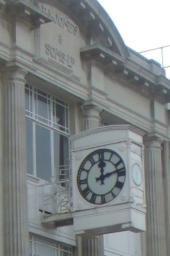
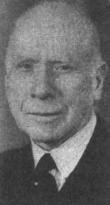
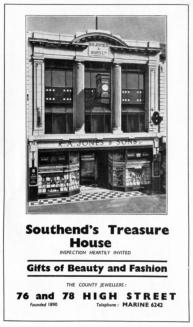
The Famous Jones Clock
Edward Cecil Jones

Southend Timeline Southend-on-Sea © 2009 - 2024. All Rights Reserved



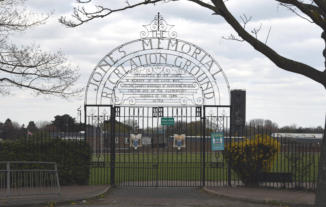

The
Gates
at
the
Jones
Memorial
Recreational
Ground,
the
gates
have
been
moved
over
the
years
from
the
their
original
position
on
the
corner
of
Sutton Road and Eastern Avenue
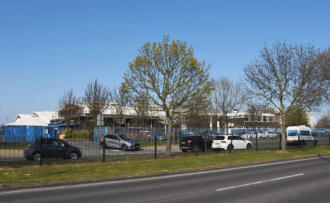
Cecil Jones Academy, Eastern Avenue, Southend
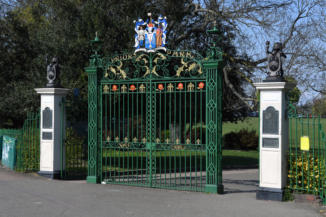
Entrance Gates at Priory Park
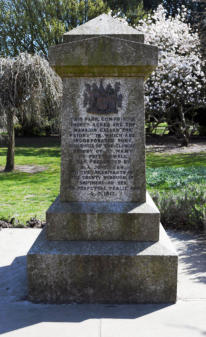
Monument
in
Priory
Park,
Inscription reads,
This
park
comprising
thirty
acres
and
the
mansion
called
“The
Priory”
in
which
are
incorporated
some
buildings
of
the
Cluniac
Priory
of
St
Mary
of
Prittlewell
was
presented
by
R.
A.
Jones
Esq.
To
the
inhabitants
of
the
county
borough
of
Southend-on-Sea
for
perpetual
public use. A .D 1917
R. A. Jones Memorial in the recreational grounds
Entrance Gates of the Victory Sports Ground

SOUTHEND CITY

Southend-on-Sea’s No 1 History Website! Documenting The Town & The Townspeople
Now Incorporating The Sea Of Change Website
Website Info:


Chalkwell ▪ Eastwood ▪ Leigh-on-Sea ▪ Prittlewell ▪ Shoeburyness ▪ Southchurch ▪ Thorpe Bay ▪ Westcliff-on-Sea
































































